Last time I posted on Cartoon Research in June 2019, I promised to return with a huge surprise for you readers. Well, here it is: one of Irv Spence’s 16mm live-action film productions, now available to the general public!

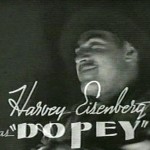

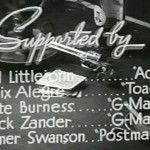

In the last few decades, several home movies featuring artists from animation’s Golden Age have become accessible. These films date from 1938 and 1939. The prime examples are two gag reels from Leon Schlesinger’s studio, shot in 16mm for their annual Christmas party. In these films, many Warner Bros. cartoon staffers perform screwball actions that reflected their animated work.
On the East Coast, animator Larry Silverman shot an 8mm color film called Makin’ ‘em Move at Paul Terry’s studio in New York which offers an insider’s look at the animation process. What has materialized from M-G-M is more ambitious—around 1939, over the course of several weekends outside of the studio, animator Irv Spence directed his own production entitled Rats in Spats, a parody of the gangster films that proliferated in theatres throughout the 1930s.
Spence does not appear in Rats in Spats, but the on-screen participants (who get their own credit in the opening titles) reveal an array of staffers in the different echelons of Metro’s animation department. In order, here’s a brief overview of the main cast (besides Harvey Eisenberg, who has a profile on this blog):
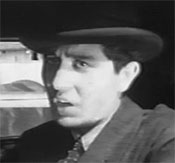 Gus Arriola plays the head gangster “Killer.” Arriola joined M-G-M’s animation studio shortly after it was restructured in September 1937. Hired as an in-betweener, he was later promoted to assistant animator. He became a story sketch man and drew character models, mainly for Hugh Harman’s unit on such films as The Bookworm (1939), The Lonesome Stranger (1940), Dance of the Weed and Abdul the Bulbul Ameer (both 1941). He later shifted to Bill Hanna and Joe Barbera’s new unit on the Tom and Jerry cartoons. While working at M-G-M in the early 1940s, he developed his own comic strip, Gordo, which celebrated his Mexican heritage. In August 1941, Arriola signed a five-year contract with United Features Syndicate for the Gordo strip and left the animation industry. The strip debuted on November 24th, 1941 and soon became popular. The daily strip paused for the duration of WWII, but Arriola found time to do a Sunday strip starting in 1943. The daily resumed in 1946 and Gordo enjoyed a long run until March 2, 1985. Arriola passed away February 2nd, 2008 in Carmel, California.
Gus Arriola plays the head gangster “Killer.” Arriola joined M-G-M’s animation studio shortly after it was restructured in September 1937. Hired as an in-betweener, he was later promoted to assistant animator. He became a story sketch man and drew character models, mainly for Hugh Harman’s unit on such films as The Bookworm (1939), The Lonesome Stranger (1940), Dance of the Weed and Abdul the Bulbul Ameer (both 1941). He later shifted to Bill Hanna and Joe Barbera’s new unit on the Tom and Jerry cartoons. While working at M-G-M in the early 1940s, he developed his own comic strip, Gordo, which celebrated his Mexican heritage. In August 1941, Arriola signed a five-year contract with United Features Syndicate for the Gordo strip and left the animation industry. The strip debuted on November 24th, 1941 and soon became popular. The daily strip paused for the duration of WWII, but Arriola found time to do a Sunday strip starting in 1943. The daily resumed in 1946 and Gordo enjoyed a long run until March 2, 1985. Arriola passed away February 2nd, 2008 in Carmel, California.
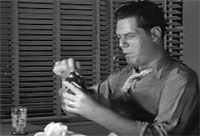 “Stod” Herbert, a close friend of Spence’s, portrays Killer’s second-in-command, Butch. George Stoddard Herbert was born in Middleville, New York on March 31, 1913, and moved to California by 1930. It is possible Herbert was an assistant animator at M-G-M during production of Rats in Spats. He became an assistant to animator Ed Love in the 1940s, at M-G-M and Bob Clampett Productions. In the mid-1950s, he became a traffic officer for the California Highway Patrol’s West Los Angeles Station. However, according to Tim Walker, Herbert worked as Ed Love’s assistant again at Hanna-Barbera in the late 1950s on the main titles and various bumpers on The Huckleberry Hound Show. From 1961 to 1966, Herbert worked as the art/animation director for Chapman 5 Productions in Glendale, an outfit that specialized in educational film strips. In the 1970s, he worked as an assistant on Ralph Bakshi’s Wizards and Hey Good Lookin’, under Tim Walker’s recommendation. Tim recalled an anecdote where Herbert and Spence would have a running feud with each other over their body fat during their time at M-G-M; in the process, Herbert coined the name “‘Pork’ Spence.” He passed away in September 2003.
“Stod” Herbert, a close friend of Spence’s, portrays Killer’s second-in-command, Butch. George Stoddard Herbert was born in Middleville, New York on March 31, 1913, and moved to California by 1930. It is possible Herbert was an assistant animator at M-G-M during production of Rats in Spats. He became an assistant to animator Ed Love in the 1940s, at M-G-M and Bob Clampett Productions. In the mid-1950s, he became a traffic officer for the California Highway Patrol’s West Los Angeles Station. However, according to Tim Walker, Herbert worked as Ed Love’s assistant again at Hanna-Barbera in the late 1950s on the main titles and various bumpers on The Huckleberry Hound Show. From 1961 to 1966, Herbert worked as the art/animation director for Chapman 5 Productions in Glendale, an outfit that specialized in educational film strips. In the 1970s, he worked as an assistant on Ralph Bakshi’s Wizards and Hey Good Lookin’, under Tim Walker’s recommendation. Tim recalled an anecdote where Herbert and Spence would have a running feud with each other over their body fat during their time at M-G-M; in the process, Herbert coined the name “‘Pork’ Spence.” He passed away in September 2003.
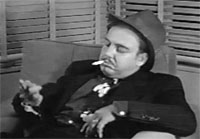 “Lefty” Price plays one of Killer’s gangsters, billed as “Fingers.” Joseph Bruce Price was born in Denver, Colorado on April 16, 1914. According to the September 1955 issue of Warners Club News, Price worked as a radio newscaster, did dramatic roles and hosted his own 15-minute program, The Friendly Philosopher. His occupation was listed as a musician when he got married at Orange, California in 1937. The December 1941 issue of the M-G-M Studio Club News mentioned an involvement with radio, performing “interesting character parts” with the John Beverly Hollywood Radio Players. Price continued working at the studio before he enlisted in the Army on August 12th, 1942. He was honorably discharged on October 13th, 1945. By April 1955, Price was hired at Warner Bros. as an in-betweener, according to Warners Club News, and later became an assistant to Harry Love, the studio’s chief effects animator. His time at Warners did not last long; the newsletter reported his departure in November 1955. Price returned to radio as a voice narrator. He died in Los Angeles on January 25, 1962.
“Lefty” Price plays one of Killer’s gangsters, billed as “Fingers.” Joseph Bruce Price was born in Denver, Colorado on April 16, 1914. According to the September 1955 issue of Warners Club News, Price worked as a radio newscaster, did dramatic roles and hosted his own 15-minute program, The Friendly Philosopher. His occupation was listed as a musician when he got married at Orange, California in 1937. The December 1941 issue of the M-G-M Studio Club News mentioned an involvement with radio, performing “interesting character parts” with the John Beverly Hollywood Radio Players. Price continued working at the studio before he enlisted in the Army on August 12th, 1942. He was honorably discharged on October 13th, 1945. By April 1955, Price was hired at Warner Bros. as an in-betweener, according to Warners Club News, and later became an assistant to Harry Love, the studio’s chief effects animator. His time at Warners did not last long; the newsletter reported his departure in November 1955. Price returned to radio as a voice narrator. He died in Los Angeles on January 25, 1962.
 Felix Alegre plays a supporting role as “Toad,” an accomplice to the gangsters in the film. Felix Reyes Alegre was born in the Phillipines on January 14, 1902, and immigrated to the States in Seattle, Washington by 1925. He worked as a janitor in a Los Angeles apartment by 1930 and joined Charles Mintz’s studio by 1933. He went over to M-G-M in the early 1940s and continued working there by 1942, according to his draft registration card. The November 1959 issue of Warners Club News notes he was hired at the studio as an assistant animator in Chuck Jones’ unit and continued working there as of March 1962.
Felix Alegre plays a supporting role as “Toad,” an accomplice to the gangsters in the film. Felix Reyes Alegre was born in the Phillipines on January 14, 1902, and immigrated to the States in Seattle, Washington by 1925. He worked as a janitor in a Los Angeles apartment by 1930 and joined Charles Mintz’s studio by 1933. He went over to M-G-M in the early 1940s and continued working there by 1942, according to his draft registration card. The November 1959 issue of Warners Club News notes he was hired at the studio as an assistant animator in Chuck Jones’ unit and continued working there as of March 1962.
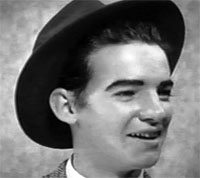 Tom Ray is cast as “The Kid,” one of the central figures in the film, as well as the animation industry. Ray was born in Arizona on August 2, 1919, and started his animation career at Leon Schlesinger’s studio in the spring of 1937. He moved to M-G-M about six months later, as they were organizing their animation department. When Irv Spence moved to M-G-M around 1938, Ray became his assistant animator, and the two became close friends. He left the studio to enlist in the Army on March 22, 1941 (and was honorably discharged on September 26, 1945). Variety reported his return to M-G-M on November 26 that year, though it’s unclear how long he stayed. Later, he worked for UPA and John Sutherland Productions, where he received one of his first animation credits on Destination Earth (1956). By February 1957, he joined Warner Bros. as an animator in Bob McKimson’s unit. He briefly animated in Freleng’s unit (credited on Trip for Tat) before settling into Chuck Jones’ crew in the early 1960s.
Tom Ray is cast as “The Kid,” one of the central figures in the film, as well as the animation industry. Ray was born in Arizona on August 2, 1919, and started his animation career at Leon Schlesinger’s studio in the spring of 1937. He moved to M-G-M about six months later, as they were organizing their animation department. When Irv Spence moved to M-G-M around 1938, Ray became his assistant animator, and the two became close friends. He left the studio to enlist in the Army on March 22, 1941 (and was honorably discharged on September 26, 1945). Variety reported his return to M-G-M on November 26 that year, though it’s unclear how long he stayed. Later, he worked for UPA and John Sutherland Productions, where he received one of his first animation credits on Destination Earth (1956). By February 1957, he joined Warner Bros. as an animator in Bob McKimson’s unit. He briefly animated in Freleng’s unit (credited on Trip for Tat) before settling into Chuck Jones’ crew in the early 1960s.
After the Warners studio closed in 1963, Ray moved with Jones at Sib Tower-12, where he animated on several cartoons and television specials for M-G-M. Jones gave him a chance to direct on two “cheater” cartoons in the Tom and Jerry series, Matinee Mouse (1966) and Shutter Bugged Cat (1967). After the Tom and Jerry cartoons discontinued, Ray worked at a large assortment of animation studios—DePatie-Freleng, Chuck Jones, Hanna-Barbera, Ralph Bakshi, Marvel, Filmation, Henson Associates, Sunbow Productions, Film Roman, Disney Television Animation, WB Animation/Amblin and Nickelodeon). His duties ranged from animation and direction to sheet timing. Ray retired from animation in 1998. He relocated to East Stroudsburg, Pennsylvania where he founded Tomstone Animation Art Galley & Studios, with his original paintings and animation art from various points in his career on display. He soon moved his studio to Virginia Beach before he passed away on April 7, 2010.
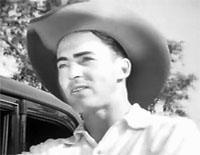 Gordy Adams plays Abner, the film’s main protagonist. As his 1940 registration card indicates, he was born October 14, 1912 in Toronto, Canada. His occupation is listed as working for M-G-M, but it is uncertain what position he held. Elmer Swanson, a friend of Spence’s, is credited as the postman in the titles, but it is difficult to determine Swanson’s biography. Two possible leads come from the 1940 Los Angeles Census and draft registration cards from 1942—an Elmer Swanson, born April 30, 1914 in Chicago, Illinois, working as a motion picture technician at the Technicolor Corporation by 1942, or another known as Elmer (Ernest) Swanson, born June 5, 1896 in Kewanne, Illinois, working for the Los Angeles Evening Herald-Express by 1942.
Gordy Adams plays Abner, the film’s main protagonist. As his 1940 registration card indicates, he was born October 14, 1912 in Toronto, Canada. His occupation is listed as working for M-G-M, but it is uncertain what position he held. Elmer Swanson, a friend of Spence’s, is credited as the postman in the titles, but it is difficult to determine Swanson’s biography. Two possible leads come from the 1940 Los Angeles Census and draft registration cards from 1942—an Elmer Swanson, born April 30, 1914 in Chicago, Illinois, working as a motion picture technician at the Technicolor Corporation by 1942, or another known as Elmer (Ernest) Swanson, born June 5, 1896 in Kewanne, Illinois, working for the Los Angeles Evening Herald-Express by 1942.
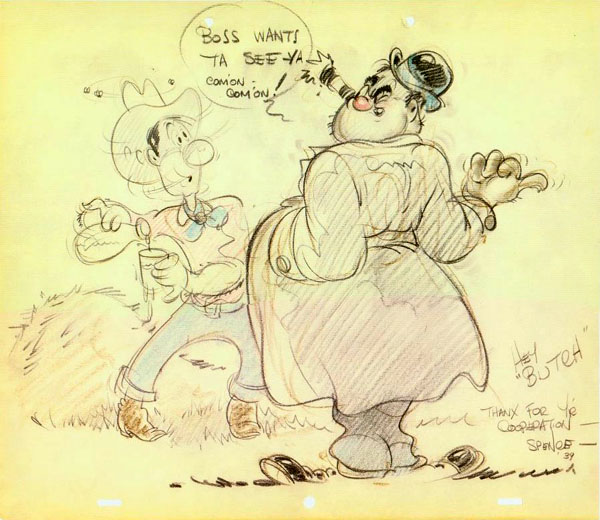
“Rats in Spats” gag drawing – courtesy of Tim Walker
Now for the plot details of the film…

Elmer Swanson (in car) as The Postman
Back at their hotel, Killer and his men review their latest plans for a bank robbery.
Gordon drives to the city to visit his brother at his apartment and notices the liquor. It seems Spence strived for symbolism in this film through opposing beverages—in simple terms, milk represents Abner’s more wholesome life out on the ranch and liquor corresponds to the Kid’s new direction with Killer and his men. During the bank robbery, Killer and the gangsters go into the bank, while “The Kid” acts as a lookout. The men run away before the police catch up to them and “The Kid” is handed the carrier full of money. He goes into his apartment, shaking and nervous with fright, and finds Abner lying on his bed. Abner confronts his brother about his new lifestyle but his brother draws a gun at him and informs him to go back to the ranch.
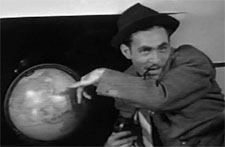
Harvey Eisenberg as “Dopey”
Soon, Abner rents an airplane to trail the gangsters. (Bill Littlejohn is the pilot in the film, credited as “Ace,” which proved handy for the film, since aviation was one of his favorite pastimes.) Abner and Ace land near the dunes, which leads to a chase and shootout with the gangsters. He kills three of the lawbreakers and gets into a fight with Killer. Somehow, Killer dies in the fistfight—a confusing detail considering Abner used gunfire to eliminate the other gangsters. Abner is declared a hero for disposing Killer’s gang and returns to the ranch dressed in fancy new clothes. Enjoying a bottle of milk, he sees ghostly figures resembling the slain gangsters, via a double-exposure effect. They seem to have reformed; they laugh and enjoy their own bottles of milk.
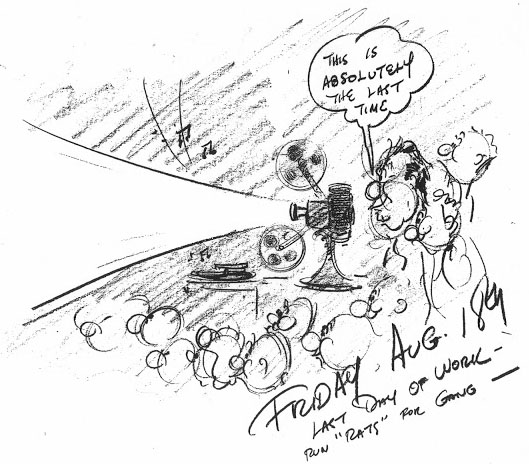
Irv Spence rewatching Rats – August 18, 1944
Irv Spence claimed the black-and-white film he used for filming Rats in Spats was relatively cheap—$3 a roll, including processing, which equates to $55.68 in 2020 dollars. As you will hear in the commentary below, Spence also claimed the film aired on early Los Angeles television in 1941. It’s unclear if this is factual, since no newspaper clippings can be found to indicate this. The film materials once belonged to its young star Tom Ray, who donated them to the Culver City Historial Society. This video is from a VHS transfer, with commentary by Irv Spence and Tom Ray from an earlier Betamax transfer, possibly from the early 1980s. Because of this, some their comments on the ghosting and afterimage of the film might be lost on the viewer.
Hope you all enjoy!
(Thanks to Jerry Beck, Frank Young, Mark Kausler, Tim Walker, Yowp and Harvey Deneroff for their help.)


 DEVON BAXTER is a film restoration artist, video editor, and animation researcher/writer currently residing in Pennsylvania. He also hosts a
DEVON BAXTER is a film restoration artist, video editor, and animation researcher/writer currently residing in Pennsylvania. He also hosts a 





















































































What a treat! Thank you for all your hard work on the research of this obscure home movie film by Irv.
Thanks for this great post, Devon! Do you know who did the snappy title lettering at the start of the film? Could be Harvey Eisenberg, who did such great lettering in his comic book stories. Too bad we don’t have more exact dates for when the picture was made, just “sometime in 1939”? I loved your attempt to summarize the story, it does meander a bit, but somehow when you’re watching the picture, it manages to entertain anyway.
Off topic, but can you post an animator breakdown of an episode of The Amazing World of Gumball?
Specifically Season 5 Episode 34?
That’s kind of an unusual request, considering it’s a current TV show. I’m afraid I wouldn’t be able to do that.
Late reply, but Devon, you can just ask Ben Bocquelet about the animator breakdown thing. I just want to know who animated what even though the show it’s current.
To tell you the truth, the first thing I thought of when I saw the words “Rats in Spats” was that weird musical number in “Heidi’s Song”. Given that title and the talent behind it, I was expecting a much funnier film. Spence and his colleagues deserve credit for stretching creatively, but unless that garbled commentary is replaced with a musical score, this is just an historical curiosity (though a fascinating one) with negligible entertainment value.
Fantastic find and splendid detective work! Outside of the very funny ending of Ride ‘Em Bosko with Hugh Harman, Rudy Ising and a third animator (Rollin Hamilton? Max Maxwell?) deciding it’s quittin’ time and leaving their beloved star stranded on the drawing board, I’m hard pressed to think of any examples, other than the Schlesinger studio Christmas party gag reels, of animators appearing onscreen in the 1930’s.
Thank you for the article on this. I have scoured the internet for any video of “Rats in spats”.It was a real treat to see it as my grandfather was George “Stod” Herbert. I had a poster sized still of the movie years ago that my dad had given to me.
Hello Devon Baxter,
Thank you for posting this article on “Rats in spats”…It’s been many years since I saw Irv’s film along with 2 others, “Rugged
Rangers” { where my Father, Harvey played an Indian Chief and filmed it up in the Lake Arrowhead area or big Bear area }..and
one other short film called “Fwoo” which was mostly about the guys playing touch football on Lot 2 at MGM where the Cartoon Studio was located……in “Rats” Irv did some great aerial filming with an airplane that belonged to one of the Animators, I cannot remember who?!….I once had videotapes of these films { provided by Tom Ray } and I hope that I can find them.
Best regards & a healthy, happy New Year 2021 to you,
Jerry